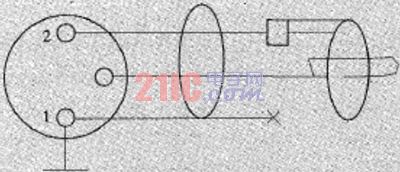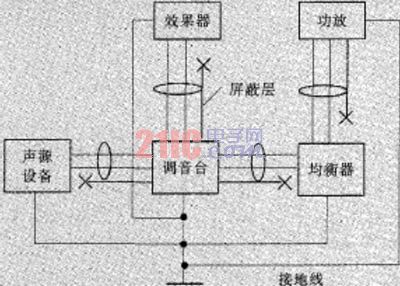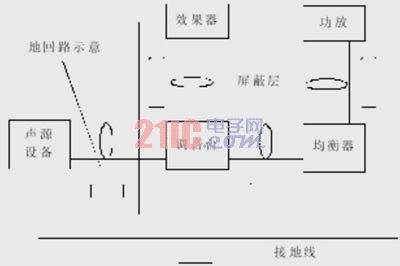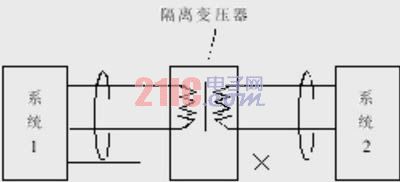Audio system noise source analysis and troubleshooting
INTRODUCTION Noise is a power supply circuit that has a certain frequency of ripple voltage entering the audio device through the power line during recording sound reinforcement or audio transmission. It is very common and very difficult to solve. Generally, the more devices that make up an audio device or the longer the signal transmission distance, the greater the noise of the system; even the audio system cannot perform normal recording or sound reinforcement. The mechanism of noise formation in audio systems is complex, and it is especially important for the main causes and solutions of system noise. This article refers to the address: http:// Figure 1 Balanced and unbalanced connections Ground loop noise In an audio system, the entire system must be grounded properly and the grounding resistance is 4 ohms. Otherwise, the induced charge generated by the device in the audio system due to various radiation and electromagnetic induction will not flow into the ground, thereby forming a noise voltage superimposed on the audio signal. Ways to Eliminate Noise The correct connection of the system is in the audio system, and there are many devices that are generally connected. Different devices have different interface types, and the connectors used are different. There are balanced and unbalanced input and output forms. In order to effectively shield the external electromagnetic radiation interference, shielded cables must be used uniformly and connected in the correct way. Good grounding is done to shield the cable with stray electromagnetic interference from the outside. The shield must have the correct connection and good grounding. In practice, all equipment suspension is one of the most commonly used measures without special ground conditions. If the shielding layers at both ends of the signal transmission line are grounded, a ground loop must be formed. When the circuit is interfered by the electromagnetic radiation of other equipment, the induced current will inevitably appear in the shielding layer of the cable, causing serious interference noise and forming ground loop noise interference, as shown in Fig. 4. In order to ensure that the system does not have a ground loop structure, only one grounding conductor can be interconnected between the devices, in the case where the requirements are not strict. The unbalanced device can be suspended, and the ground wire of the next-level device is shared by the audio signal line. That is to say, the chain grounding is adopted, but the number of stages of the chain grounding cannot be too much, generally not more than two levels. Otherwise it will cause a serious increase in noise. System isolation is in some large audio systems, often consisting of subsystems centered on multiple consoles, or interconnected with video equipment systems. Sometimes it is necessary to transmit signals to a remote audio and video system, and broadcast stations even transmit audio broadcast live signals on a common telephone line. These long-distance connections, because different subsystems have their own independent grounding system, once each subsystem is connected to the ground, it will inevitably form grounding noise, as shown in Figure 5; on the other hand, due to the long transmission distance, the transmission line The grounding resistance of the shielding layer will increase, even if an unshielded transmission line or the like is used, it is easy to introduce a large amount of external electromagnetic field radiation to interfere with noise. In practical applications, if each system works alone, the noise can be controlled within a permissible level by reasonable wiring and grounding, but when multiple subsystems are interconnected, single-ended shield grounding or long-line segmented grounding is used. There is also no way to solve the radiated interference noise caused by long-distance transmission. Especially when transmitting over a large telephone network, the best measure at this time is to use isolation. An audio isolation transformer is installed between multiple systems to isolate them from each other. The ground lines of multiple subsystems must not be connected, and the different subsystems are completely isolated by optical isolation, as shown in Figure 6, the effect is better. Figure 5 Isolated processing between systems Power Purification In order to isolate the interference noise generated by the public power grid, it is best to use an isolated clean power supply or an isolation transformer. The grounding end of the isolation transformer or the clean power supply must ensure reliable and good grounding. Otherwise the isolation is not good. To isolate from some high-powered electrical equipment with strong interference, supply power separately, or install a filter at the power input end of the audio equipment to filter out interference noise. Conclusion This paper mainly discusses the external interference noise problem of audio and sound reinforcement equipment. Of course, some noise is thermal noise generated by circuits inside the device. Some are field environmental noise directly contained in the input signal source or picked up by the microphone. Usb Type-C,Type-C Data Cable,Aluminum Alloy Data Cable,Zinc Alloy Data Cable Dongguan Pinji Electronic Technology Limited , https://www.iqdatacable.com
Main causes of noise Electromagnetic radiation interferes with stray electromagnetic wave radiation interference in noise environment, such as high-frequency electromagnetic wave radiation interference of communication equipment such as mobile phones and walkie-talkies, electric pulse radiation such as elevators, air conditioners, automobile ignition, electric welding, etc. The radiation of the silicon-controlled rectifier control device will be mixed directly into the transmission signal through the transmission line to form noise or through the poorly shielded device casing to interfere with the internal circuit to generate interference noise. Practice has shown that in some special occasions, such as the large-scale use of thyristor dimming equipment In the studio, etc., if reliable shielding and grounding measures are not taken, the noise will be very serious).
Power supply interference noise In addition to electromagnetic radiation, the introduction of interference noise in the power supply part is also the main cause of noise (the urban power grid is connected to various lighting equipment, power equipment, and control equipment, forming a very serious interference source (such as connecting in the same Light control equipment, air conditioners, motors and other equipment in the power grid will generate spikes, surge currents, ripple voltages of different frequencies on the power line. When the power supply line is plugged into the power supply of the audio equipment, there will always be some interference noise. The voltage cannot be effectively filtered out by the power supply circuit of the audio device, and noise will be formed inside the device (especially, the high-power device whose electromagnetic compatibility performance in the same power grid does not meet the requirements is the main reason for interference with the audio device). 

Figure 2 Unbalanced conversion to balanced transmission 
Figure 3 device star grounding method 
Figure 4 Schematic diagram of ground loop formation
If there is a ground potential difference between the grounding resistances of different devices due to different grounding resistance, or when there is a loop in the internal grounding of the system, ground noise will be introduced. When two different audio systems are interconnected, noise may also be generated. The noise is caused by the direct connection of the ground of the two systems.
Circuit noise inside the device The electrical noise generated by the internal electronic components can meet the required specifications when working alone in a single device. But when multiple devices are cascaded, their noise will accumulate. In practical applications, some low-grade devices may cause the humming of the device itself to increase due to poor internal power supply filtering, and sometimes serious noise is formed in the system.
It is well known that when the audio signal transmission adopts the balanced transmission mode, the external interference source produces a common mode interference level equal to the ground loop for each of the two signal lines in the cable. At the input of the internal amplifier of the device, the common mode voltages on the two signal lines are replaced by differential mode voltages, which cancel each other out and form an interference voltage. Therefore, you should use a balanced connection whenever possible.
When connecting to an unbalanced output device, the port of the balanced device can be connected to the port of the unbalanced device directly with a single-core shielded cable. Instead of using a balanced-unbalanced converter. The noise induced by the shield is mixed into the audio signal to increase noise. This will be a major way to introduce noise. The recommended approach is to use a double-core shielded cable, whether balanced or unbalanced, and the shield is grounded only at the balanced output or input end, as shown in Figure 1. When the two ends are unbalanced connections, if the transmission distance is long, it is better to use a balanced-unbalanced converter or an audio isolation transformer to convert to balanced transmission, as shown in Figure 2. Today's audio equipment connections are commonly connected by voltage jumpers. That is, the line output of all audio devices is a low-impedance output, and the line input as a load uses a high-impedance input. In addition to the connection of the amplifier and the speaker, there is generally no need to specifically consider impedance matching.
But this is a very unstable working condition, which often produces unstable random noise, so the whole system should be well grounded. First, a special ground wire should be provided with a grounding resistance of less than 4 ohms. The neutral line of the power supply cannot be used as the ground of the audio system equipment. In outdoor places, you can consider laying a temporary ground wire. The easiest way is to insert a steel pipe or aluminum alloy pipe about one meter long into the ground and do salt intrusion treatment. The effect is very good.
A typical system is a link system in which multiple devices are connected by cables. It is easy to form a chain grounding method by its shielding system. When electromagnetic radiation or static induction noise is generated on a device, the entire system generates an induced voltage due to the grounding system composed of the shield of the transmission line and the outer casing of the iron device. In turn, the system produces a certain level of noise, which is especially noticeable on audio systems with long links. Therefore, the system should try to avoid the use of chain grounding, but should use star grounding. That is, each device is connected to a unified grounding point through a dedicated ground wire, which requires that the shielding layer of the audio cable connecting all the devices be grounded at one end. Connect the ground wire of each device at the shield to a grounding point through a special wire, as shown in Figure 3.
The connection problem between the cabinets should also be taken seriously. For example, many devices are installed on the same rack. If each device is connected to the ground wire separately, the two devices are connected to each other because they are mounted on the same rack. Ground loop. 

Figure 6 Optical isolation method consisting of two MD recorders
Sometimes it is also possible to find a connection with the least noise by changing the position of the live and neutral inputs of a single-phase powered audio device. This can also reduce some noise interference. Also note that the audio transmission line must not be routed in parallel with the power line. To cross-wire the audio cable and the power cable, AC noise interference can also be reduced.